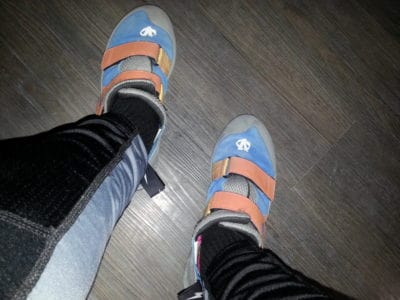After weeks of renting, I will soon be buying my own shoes for bouldering. The amount of information on climbing shoes can be overwhelming, so I am sharing with you the basics that will guide my decision on what to buy.
The first thing I learned is that one’s first bouldering shoes will be a lot different from the shoes that will be needed later after having gained some strength and skill in the gym.
Your first bouldering shoes should be reasonably snug – but not tight – with a straight, symmetrical sole to allow comfortable walking, and a Velcro closure for quick on and off. The shoes should have some stiffness to provide support while your feet are gaining strength. A shoe made of synthetic materials will give the most precise fit because it won’t stretch out. The shoe should not rub against the ankle when you flex and rotate your foot.
When you gain experience and have been bouldering for a while, your feet will be stronger, you will have learned effective foot placement, and you will have a much better idea of how well you land on your feet. These skills will help you to refine your next choice of climbing shoes, but for now, you need shoes that will provide the extra support and safety that a beginner needs.
The First Consideration: How Stiff Is the Shoe?
Deciding on the stiffness of a bouldering shoe is a tug of war between the benefits of flexibility, which overall gives better sensitivity and performance, and the benefits of stiffness, which offers support and easier edging on footholds.
It is better to start off with a stiffer shoe for the first pair because although pliable shoes offer the best sensitivity, your feet will initially need a stiffer shoe to avoid strain injury. As you gain foot strength, you will be able to progress to more flexible shoe options.
The stiffest choice is a board-lasted shoe, where the foot rests on an insole. Unless you are a very heavy person, however, board-lasted shoes are not the best option because of the extreme lack of foot sensitivity.
Slip-lasted shoes are much more suitable for indoor bouldering. These types of shoes curve around the foot like a sock, and they offer more sensitivity because there are fewer shoe layers between your foot and the wall.
Most climbing shoes are slip-lasted. You can identify a slip-lasted shoe by the sewing seam showing on the inside of the foot bed. In contrast, the inside of a board-lasted shoe will look like the inside of a regular shoe, with an insole.
Slip-lasted shoes are available in different levels of stiffness. If you have a slight build, you may be fine with a more pliable slip-lasted choice, but someone with a heavier build will need a stiffer shoe for the extra support.
Now Let’s Look at Shoe Shape
An aggressive climbing shoe will have a downturned toe and an asymmetrical shape that curves the foot inwards to put most of the force on the large toe. These require strong feet and precise footwork, and are not appropriate for beginners.
For your first pair of climbing shoes, choose a flat bottom and a more symmetrical shape that does not distort the foot. A flat and symmetrical shoe, where there is no inward curve, is a better choice for a beginner because it provides the most comfort and safety. Any torque in the shoe, such as that created by a downturned toe and curved shoebox, increases the chance of an ankle sprain when jumping down from the wall.
Also, as a beginner, you will find that flat symmetrical shoes provide the most comfort for long training sessions.
Yes, Style Is Actually Important
Style matters because it affects how good of a fit you can get, and how quick or slow it will be to put on and take off the shoes.
What is meant by shoe style is actually related to the type of closure on the shoe. The closure can be slipper, lace-up, or Velcro.
Slipper styles are the most sensitive option, but they have no laces and therefore are not adjustable. These need to be sized very tight to prevent any foot movement inside the shoe. The advantage of slippers is that they are quick to slip on and off, which is very handy in bouldering gyms. However, due to their flexibility, slipper styles require a lot of foot strength and are therefore not a good choice for beginners. Because of the tight fit, they are also uncomfortable to walk around in, and are painful if kept on for long hours of bouldering.
Lace-ups are a great option for a customized fit. Climbing shoes do stretch out with use, and the laces will allow you to adjust for this. However, because of the laces it takes more time to get the shoes on and off, which can be annoying in a gym environment.
The best compromise between a slipper style and lace-ups are shoes with a Velcro strap closure. The Velcro closure makes it quick and easy to get the shoes on and off, and it allows you to adjust the fit as needed.
Trying on the Shoes: Tips for When You’re at the Store
For bouldering, you will be using rock climbing shoes, which can be purchased at a sports equipment store or at a local rock climbing gym that has a shop. If you’re in Canada, Mountain Equipment Co-op is a great place to buy climbing equipment.
Climbing shoes are tricky to fit, so it is much better to buy them in person than over the internet. Here are some tips to ensure a successful purchase:
- The most important thing to consider is that your foot should not have room to move around in the shoe. A loose-fitting shoe will greatly reduce your ability to climb well.
- You want a fit that is snug, but not painful. There should be no air space anywhere around your foot.
- Your heel should be firmly held in place, with no slippage when you try to pull down on the heel of the shoe. The last thing you want is the shoe slipping off when you are high up on a wall.
- Shoes do stretch out with use. Leather shoes, especially unlined leather shoes, will stretch more than those that are synthetic or lined. For a longer-lasting fit, it may be best to start out with a shoe made mostly of synthetic materials.
- Stores that sell climbing equipment often provide a small bouldering panel for trying out the shoes, so be sure to take advantage of this. Stand on a hold, using first the inside and then the outside edge of the shoe to get a feel for its performance. While on the foothold, also test for fit: you do not want your foot to be shifting at all inside the shoe.
- Do not wear socks when trying on the shoes if you will not be wearing socks when bouldering. Most people don’t wear socks in their climbing shoes because it adds another layer between your foot and the wall, which reduces sensitivity.
- Consider the time of day that you will be bouldering, as feet tend to swell later in the day. For example, if you will be bouldering mostly in the mornings, and you purchase in the evening when your feet are more swollen, you might end up with shoes that are not quite as snug as you had hoped.
Aim for a shoe that is mid-priced, around $100 to $150. The most expensive shoes are meant for highly-experienced, competitive climbers, and the least expensive ones may be of poor quality materials that will give you discomfort and bad performance.
Take your time in choosing, as the shoes will usually not be returnable once they have been worn.
Final Thoughts on Your First Bouldering Shoe Selection
A good pair of climbing shoes will set you on the path to efficient and competent bouldering. Keep in mind that renting is a good way to get started, as it will give you an idea of what to look for when purchasing your own. The bouldering gym may ask that you wear socks with their rental shoes.
Your first pair won’t be your last, but remember the important points to look for in shoes appropriate for a beginner: there should be enough stiffness and support to allow you to build strength without risking strain, a comfortable but snug fit that will make it possible to develop proper climbing technique, and a flat, even sole so that you can jump down safely from the bouldering wall.
Update: So, which shoes did I end up getting? Click here to see the recommended beginner’s climbing shoes. They’re a huge improvement on the rentals.

